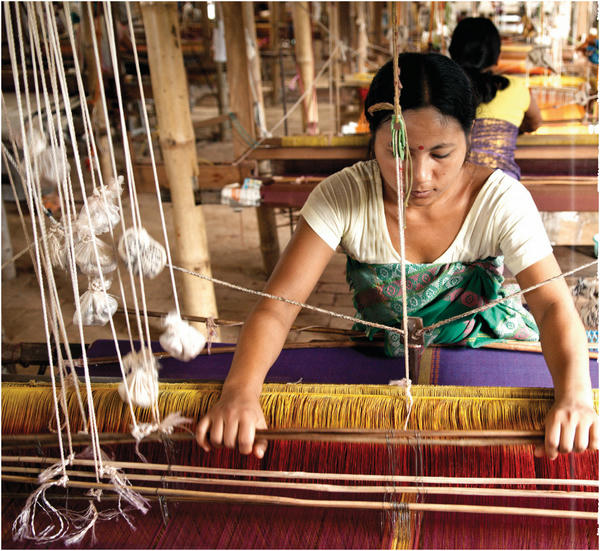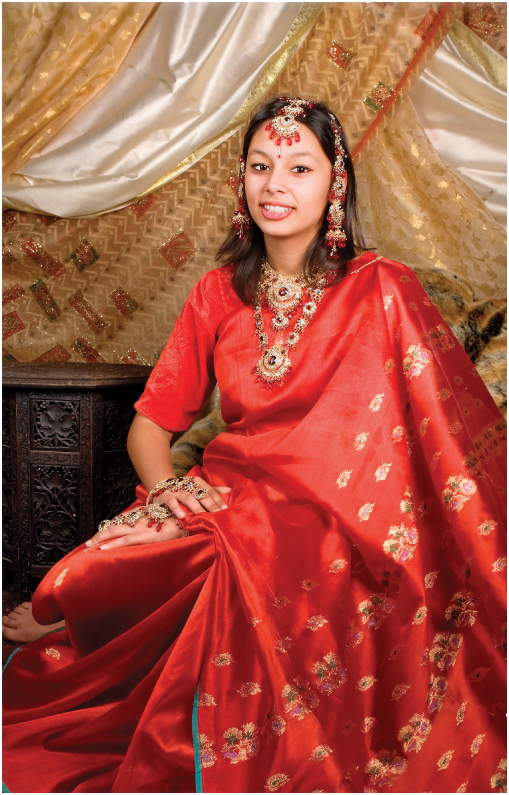EDUCATIONAL INSIGHT§
Fabric Begets Fashion
The Indian sari remains the pinnacle
of weaving skill and designer apparel
![]() ITH TUCKS AND PLEATS, flowing folds and knotted ties, Hindus have for fifty centuries fashioned impeccable apparel from lengths of unstitched cloth. Ranging from simple body coverings to masterfully embroidered works of weaving and wearing, the sari is without question the reigning queen of the world’s traditional dresses. No attire elicits images of India more strongly than the sari, and no other culture’s costume has remained in vogue longer—over 5,000 years. While the sari soars in social circles, the time-worn garbs of other world cultures, such as Japanese kimonos, have largely faded from public view—usurped by Western garb and scuttled to museum displays or limited to ceremonial occasions. In contrast, the sari, still the daily dress of most village Indians and the preferred attire of millions of urbanites, is now the rave in big-city clothing cliques around the globe. It commands the respect and admiration of chic designers who revere the silken swath of cloth as a fashion stalwart, an icon that has transcended time’s trendiness. What has saved the sari from extinction is its exceptional quality of being ever open to the creative inspiration of its wearer. While tailored clothes are strictly one-way-forward, up or down, and either casual or formal, the sari stretches beyond such limitations. A single unstitched weave can become an entire wardrobe, all depending upon the chosen methods of draping. No other garb has such a range of possibilities. In this educational Insight, we explore the global popularity of this timeless attire and present some excellent resources about the sari and the fine art of draping. §
ITH TUCKS AND PLEATS, flowing folds and knotted ties, Hindus have for fifty centuries fashioned impeccable apparel from lengths of unstitched cloth. Ranging from simple body coverings to masterfully embroidered works of weaving and wearing, the sari is without question the reigning queen of the world’s traditional dresses. No attire elicits images of India more strongly than the sari, and no other culture’s costume has remained in vogue longer—over 5,000 years. While the sari soars in social circles, the time-worn garbs of other world cultures, such as Japanese kimonos, have largely faded from public view—usurped by Western garb and scuttled to museum displays or limited to ceremonial occasions. In contrast, the sari, still the daily dress of most village Indians and the preferred attire of millions of urbanites, is now the rave in big-city clothing cliques around the globe. It commands the respect and admiration of chic designers who revere the silken swath of cloth as a fashion stalwart, an icon that has transcended time’s trendiness. What has saved the sari from extinction is its exceptional quality of being ever open to the creative inspiration of its wearer. While tailored clothes are strictly one-way-forward, up or down, and either casual or formal, the sari stretches beyond such limitations. A single unstitched weave can become an entire wardrobe, all depending upon the chosen methods of draping. No other garb has such a range of possibilities. In this educational Insight, we explore the global popularity of this timeless attire and present some excellent resources about the sari and the fine art of draping. §

